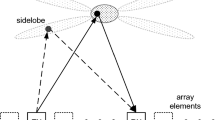Abstract
This paper estimates the side lobe levels from the received echo data, and proposes and compares three types of filters that can be used to suppress them in an ultrasound image. Ultrasound echo signals from the off-axis scatterers can be modeled as a sinusoidal wave whose spatial frequency in the lateral direction of a transducer array varies as a function of the incident angle. The received channel data waveform due to side lobes have a spatial frequency of an integer plus a half. Doubling the length of the channel data by appending zeros and taking the discrete Fourier transform of the elongated data makes the spatial frequency of the channel data due to side lobes become an integer. Thus, it is possible to estimate the complex amplitude of the side lobes. Adding together all the channel data of the estimated side lobes, we can obtain the side lobe levels present in ultrasound field characteristics. We define the summed value as a quality factor that is used as a parameter of side lobe suppression filters. Computer simulations as well as experiments on wires in a water tank and a cyst phantom show that the proposed filters are very effective in reducing side lobe levels and that the amount of computation is smaller than that of the minimum variance beamforming method while showing comparable performance. A method of estimating and suppressing side lobes in an ultrasound image is presented, and the performance of the proposed filters is found to be viable against the conventional B-mode imaging and minimum variance beamforming methods.
















Similar content being viewed by others
References
Kim JH, Song TK, Park SB. Pipelined sampled delay focusing in ultrasound imaging. Ultrason Imaging. 1987;9(2):75–91.
Macovski A. Medical imaging systems. Englewood Cliffs: Prentice Hall; 1983.
Goodman JW. Introduction to Fourier optics. Greenwood Village: Roberts and Company Publishers; 2005.
Keitman-Curdes O, Brendel B, Marg C, Ermert H. Optimization of apodizations based on the sidelobe pressure energy in simulated ultrasound fields. Conf Proc IEEE Ultrason Symp. 2002; 2:1677–80.
Bae MH, Jeong MK. A study of synthetic-aperture imaging with virtual source elements in B-mode ultrasound imaging systems. IEEE Trans Ultrason Ferrelectr. 2000;47(6):1510–9.
Vignon F, Burcher MR. Capon beamforming in medical ultrasound imaging with focused beams. IEEE Trans Ultrason Ferrelectr. 2008;55(3):619–28.
Synnevåg JF, Austeng A, Holm S. Benefits of minimum variance beamforming in medical ultrasound imaging. IEEE Trans Ultrason Ferrelectr. 2009;56(9):1868–79.
Asl BM, Mahloojifar A. Minimum variance beamforming combined with adaptive coherence weighting applied to ultrasound medical imaging. IEEE Trans Ultrason Ferrelectr. 2009;56(9):1923–31.
Asl BM, Mahloojifar A. Contrast enhancement and robustness improvement of adaptive ultrasound imaging using forward-backward minimum variance beamforming. IEEE Trans Ultrason Ferrelectr. 2011;58(4):858–67.
Nilsen CIC, Holm S. Wiener beamforming and the coherence factor in ultrasound imaging. IEEE Trans Ultrason Ferrelectr. 2010;57(6):1329–46.
Kim K, Park S, Kim J, Park SB, Bae M. A fast minimum variance beamforming method using principal component analysis. IEEE Trans Ultrason Ferrelectr. 2014;61(6):930–45.
Hollman KW, Rigby KW, O’Donnell M. Coherence factor of speckle from a multi-row probe. Conf Proc IEEE Ultrason Symp. 1999;2:1257–60.
Li PC, Li ML. Adaptive imaging using the generalized coherence factor. IEEE Trans Ultrason Ferrelectr. 2003;50(2):128–41.
Lediju MA, Trahey GE, Byram BC, Dahl JJ. Short-lag spatial coherence of backscattered echoes: imaging characteristics. IEEE Trans Ultrason Ferrelectr. 2011;58(7):1377–88.
Camacho J, Parrilla M, Fritsch C. Phase coherence imaging. IEEE Trans Ultrason Ferrelectr. 2009;56(5):958–74.
Fritsch C, Camacho J, Parrilla M. New ultrasound imaging techniques with phase coherence processing. Ultrasonics. 2010;50(2):122–6.
Li ML, Li PC. Improved Fourier transform-based parallel receive beam formation. Ultrason Imaging. 2003;25(2):73–84.
Dahl JJ, Trahey GE. Off-axis scatterer filters for improved aberration measurement. Conf Proc IEEE Ultrason Symp. 2003; 2:1094–7.
Jeong MK. A Fourier transform-based sidelobe reduction method in ultrasound imaging. IEEE Trans Ultrason Ferrelectr. 2000;47(3):759–63.
Byram B, Die K, Dumont D. An improved acoustic clutter model and direct in vivo assessment of off-axis and multipath clutter energy in the liver. Conf Proc IEEE Ultrason Symp. 2014;531–4.
Byram B, Jakovljevic M. Ultrasonic multipath and beamforming clutter rejection: a chirp model approach. IEEE Trans Ultrason Ferrelectr. 2014;61(3):428–40.
Jeong MK, Kwon SJ. Estimation of side lobes in ultrasound imaging systems. Biomed Eng Lett. 2015;5(3):229–39.
Jeong MK, Kwon SJ. A novel side lobe estimation method in medical ultrasound imaging systems. Conf Proc IEEE Ultrason Symp. 2015;1–4.
Ziomek LJ. Fundamentals of acoustic field theory and space-time signal processing. Boca Raton: CRC Press; 1995.
Oppenheim AV, Schafer RW. Discrete-time signal processing. 3rd ed. Upper Saddle River: Pearson Education; 2009.
Jensen JA, Nikolov SI. Fast simulation of ultrasound images. Conf Proc IEEE Ultrason Symp. 2000;2:2721–4.
http://www.alpinion.co.kr. Accessed 4 June 2016.
http://www.sunnuclear.com/snc_site/solutions/diagnostic/subcat/ultrasoundqa. Accessed 4 June 2016.
Chen J, Yiu BYS, So HKH, Yu ACH. Real-time GPU-based adaptive beamformer for high quality ultrasound imaging. Conf Proc IEEE Ultrason Symp. 2011;474–7.
Bae MH, Park SB, Kwon SJ. Fast minimum variance beamforming based on Legendre polynomials. IEEE Trans Ultrason Ferrelectr. 2009;63(9):1422–31.
Acknowledgements
This work was supported by the Daejin University Research Grants in 2016.
Conflict of interest
Kwon SJ declares that he has no conflict of interest in relation to the work in this article. Jeong MK declares that he has no conflict of interest in relation to the work in this article.
Author information
Authors and Affiliations
Corresponding author
Rights and permissions
About this article
Cite this article
Kwon, S.J., Jeong, M.K. Estimation and suppression of side lobes in medical ultrasound imaging systems. Biomed. Eng. Lett. 7, 31–43 (2017). https://doi.org/10.1007/s13534-016-0002-3
Received:
Revised:
Accepted:
Published:
Issue Date:
DOI: https://doi.org/10.1007/s13534-016-0002-3




